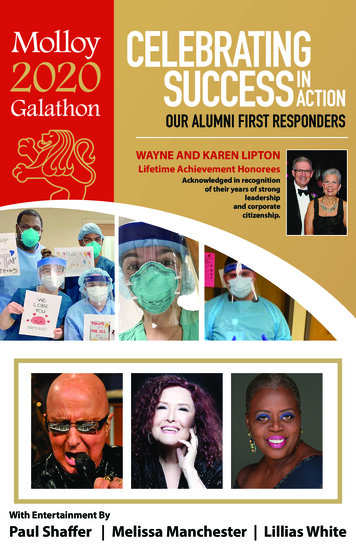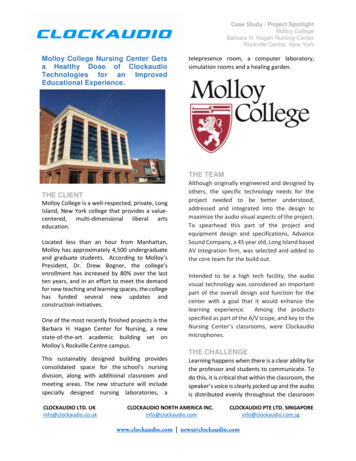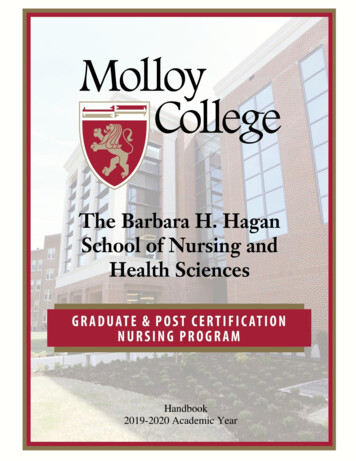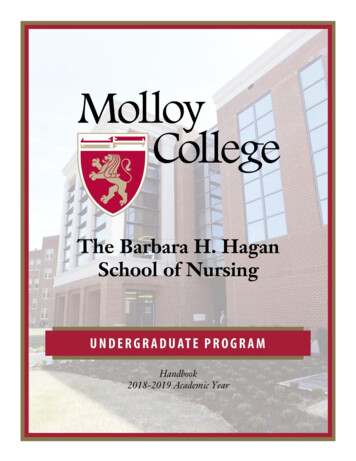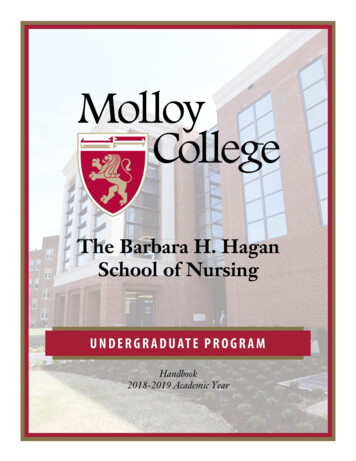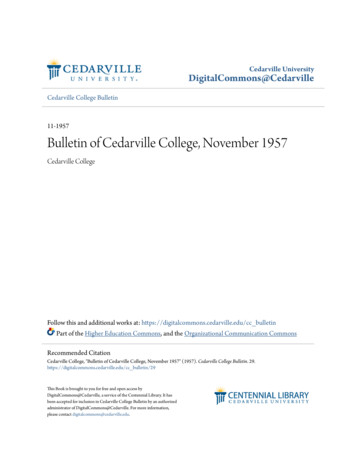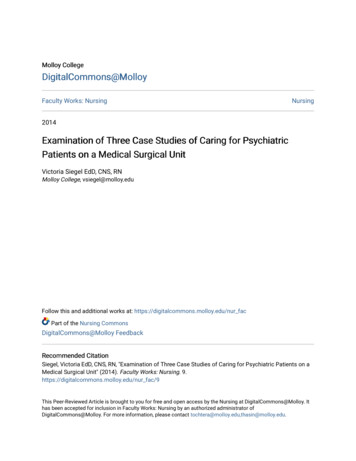
Transcription
Molloy CollegeDigitalCommons@MolloyFaculty Works: NursingNursing2014Examination of Three Case Studies of Caring for PsychiatricPatients on a Medical Surgical UnitVictoria Siegel EdD, CNS, RNMolloy College, vsiegel@molloy.eduFollow this and additional works at: https://digitalcommons.molloy.edu/nur facPart of the Nursing CommonsDigitalCommons@Molloy FeedbackRecommended CitationSiegel, Victoria EdD, CNS, RN, "Examination of Three Case Studies of Caring for Psychiatric Patients on aMedical Surgical Unit" (2014). Faculty Works: Nursing. 9.https://digitalcommons.molloy.edu/nur fac/9This Peer-Reviewed Article is brought to you for free and open access by the Nursing at DigitalCommons@Molloy. Ithas been accepted for inclusion in Faculty Works: Nursing by an authorized administrator ofDigitalCommons@Molloy. For more information, please contact tochtera@molloy.edu,thasin@molloy.edu.
Open Journal of Nursing, 2014, 4, 907-911Published Online December 2014 in SciRes. 10.4236/ojn.2014.413096Examination of Three Case Studies of Caringfor Psychiatric Patients on a MedicalSurgical UnitVictoria SiegelMolloy College, Rockville Centre, New York, USAEmail: vsiegel@molloy.eduReceived 20 October 2014; revised 19 November 2014; accepted 30 November 2014Academic Editor: Donna M. Wilson, University of Alberta, CanadaCopyright 2014 by author and Scientific Research Publishing Inc.This work is licensed under the Creative Commons Attribution International License (CC tractMedical surgical nurses frequently care for patients with psychiatric disorders as one in fourpeople have a diagnosed psychiatric disorder. Since these nurses specialize in medical surgicalnursing, they often feel they lack the expertise to care for patients with co-morbid psychiatricproblems. This article presents three case studies and delineates nursing care strategies whichcould assist the medical-surgical nurses in caring for this population.KeywordsPsychiatric Patients, Medical Surgical Unit, Nursing Education, Case Studies1. IntroductionHistorically, health care professionals have been educated in silos. In recent years, inter-professional educationhas been addressed in the literature so the different professions understand and respect each other’s roles andcontributions to the health care team. In addition, we care for our patients in silos and separate psychiatric patients from medical-surgical patients. This separation leads to the caretakers being expert in their care, yet leavesthe patients with dual problems without the expertise of their caregivers in both areas.The purpose of this article is to address this issue and increase the comfort level of the medical-surgical nursein caring for patients who also have psychiatric problems. Suffice it to say, on the flip side the psychiatric nurseswould also not be comfortable assessing a post-op patient or caring for patients who have chest tubes!Mental disorders are common in the United States. Over twenty six percent of Americans 18 or older, one inHow to cite this paper: Siegel, V. (2014) Examination of Three Case Studies of Caring for Psychiatric Patients on a MedicalSurgical Unit. Open Journal of Nursing, 4, 907-911. http://dx.doi.org/10.4236/ojn.2014.413096
V. Siegelfour adults, suffer from a diagnosable mental disorder in a given year. This translates into approximately 57.7million people [1].Many people do not seek psychiatric treatment due to the stigma of this category of illnesses or due to a lackof insurance coverage. Since such a high percentage of adults have mental illness, many of them also have medical or surgical needs and are admitted to medical surgical units. The health care system perpetuates the stigmaof mental illness in subtle ways by not having a psychiatric patients name on the outside of the chart when all ofthe medical surgical patient’s names are on the outside of charts. In so doing, we are “advertising” that it issomething to be ashamed of.Many nurses on medical-surgical units are sometimes uncomfortable caring for patients who also have a psychiatric disorder. I sometimes hear “I didn’t go into psych for a reason” or “Psych scares me. I don’t know whatto say to psych patients.” Yet, frequently, patients with psychiatric diagnoses are admitted to medical-surgicalunits.Let’s examine a few case studies.2. Case Presentation 1A 51-year-old female with a history of bipolar disorder presented to the ER claiming she was feeling suicidal.She had jumped from a second story window and c/o pain in her back and both ankles. She was alert andoriented, but combative on admission to ED. C-collar in place, handcuffed to stretcher. “I was on the floor, myhusband was trying to hurt me, so I jumped.” “I wanted to hurt myself, and I wanted to hurt my husband.”The police reported that the patient was aggressive towards husband with scissors, attempted to cut self onwrists. Patient’s husband has a restraining order against her. “She reported that her husband had been abusive toher through the years and he recently threatened to kill her.” Her ex-husband reported she has been deterioratingfor 5 weeks, belligerent, aggressive, not sleeping and drinking wine.On admission—the patient reported she was depressed, suicidal, and scared. She reported a recent decreasedneed for sleep, euphoric mood, and racing thoughts. Mental status: appearance—poor hygiene, disheveled; motoractivity—restless; affect—agitated; mood—depressed and anxious; speech—soft; thought process—circumstantial;judgment—poor impulse control, maladaptive; Insight—poor. Intelligence is below average. Concentration- distracted.Pt. suffered multiple comminuted fractured of her left ankle and fracture of L5, these injuries resulted fromher jumping out of the second story window. Surgical intervention was not needed but the patient was admittedto a medical surgical unit.Psych history—she reported past history of manic symptoms along with psychotic symptoms. A decreasedneed for sleep, euphoria, bizarre behavior, racing thoughts, and increased goal oriented activity has led to hospitalizations in the past along with paranoia. She has had 12 psych admissions, most recent admission was 2 yearsago. Reports one past suicide attempt 6 yrs. ago when she left her husband and was in a shelter. She was discovered by staff and brought to the hospital. She then divorced her husband.She reports an occasional glass of beer or wine, no street drugs or abuse prescribed medications. However,her blood alcohol level was negative and urine toxicology screen was negative.Family psych history—mother had schizophrenia and alcohol dependence and her niece committed suicide.Hospital course—on admission patient was depressed and reported feelings of hopelessness, helplessness,suicidal ideation and paranoia. Patient was started on Risperadal, discontinued from Wellbutrin as it was thoughtit may have been activating the patient and inducing mixed symptoms as well as mania. Patient also placed onZoloft for depressed mood and continued on Depakote. Mood improved, her affect is stabilized and her paranoiasymptoms diminished. The patient remained on the medical-surgical floor for the 13 days of her hospitalization.She was managed very well on the unit, and did not have any behavioral problems. She was followed by thepsych NP, nurses and her MD. The nurses reported not understanding her condition and they were wary of caring for her.2.1. DiscussionIn the above case presentation the nurses reported being wary of caring for the patient and not knowing what tosay to her and/or how to interact with her. Many people have bipolar disorder and it would be helpful if medical-surgical nurses understood the illness and how to care for persons with the disorder.908
V. Siegel“Bipolar disorder is a chronic illness with recurring episodes of mania and depression that can last from oneday to months. This mental illness causes unusual and dramatic shifts in mood, energy and the ability to thinkclearly.” “More than 10 million Americans have bipolar disorder.” Bipolar disorder can be managed successfully with medication [2].By educating the medical-surgical nurses regarding bipolar disorder and therapeutic communication techniques listed below, they would have been more comfortable in caring for the above patient.Therapeutic Communication Techniques:1. Use of broad opening statements, which encourages the patient to take the lead in a conversation.2. Giving recognition—indicates awareness of an accomplishment3. Making observations—sharing perceptions of behaviors4. General leads—implies the nurse is following the course of the conversation and is interested in hearingmore.5. Reflecting feelings restating content—mirrors feelings and ideas the patient has expressed and directed itback to the patient.6. Verbalizing the implied—allows nurse to validate feelings, ideas expressed.7. Clarifying content—clarifies unclear communication and helps patient clarify own thoughts or feelings.8. Offering self/silence—this is the most important technique and it communicates caring and is the essenceof nursing.9. Presenting reality—assures the patient of what is real to the nurse.10. Voicing doubt—used to give patient an opportunity to re-examine negative beliefs about self or to allayfears arising from distorted perception [3].2.2. ConclusionThe patient in case study #1 was not problematic on the unit, but the nurses felt ill prepared to care for her psychiatric disorder. By increasing understanding of mental illnesses and the use of therapeutic communicationtechniques, nurses will feel more comfortable and patients will benefit from their care.3. Case Presentation 231-year-old woman with a history of: depression; seizure disorder; anemia; diabetes; hypertension; end stagerenal disease; polysubstance abuse and malfunction of hemodialysis catheter.When the patient was age 14, she was diagnosed with diabetes, this led to hypertension; she had a son at age21 and the pregnancy led to kidney failure and the need to go on dialysis. She has since had several access revisions. The patient also reported having a history of depression, anxiety and post-traumatic stress disorder (butwould not elaborate).When I first introduced myself to this patient, she was very angry and was facing away from me, staring at thewall. She was on isolation for MRSA and VRE and this truly made her feel more isolated. I asked if I could assist her with anything and she said she needed some sheets on her bed so she could lie down and she neededpain medication. She was very itchy and needed the linens washed in Ivory. I offered to go and collect the sheetsfrom housekeeping and when I came back with the sheets, she was then engaging and no longer angry and wespoke. Through my actions, I demonstrated caring and this is extremely important to remember as nurses [4].The patient wanted to take Ambien (a sleeping medication) at 3:00 pm. The nursing staff was incorrectlyviewing this as drug seeking behavior. She did not truly want to take Ambien at 3 pm, but was trying to expresshow poorly she felt and she wanted the nurses to understand this.3.1. DiscussionPerhaps the nursing staff would have been more comfortable caring for this patient if they understood poly-substance abuse and the frequency with which persons with mental illness self-medicate with alcohol or illegal substances. It is referred to as dual diagnosis.“Dual diagnosis is a term used to describe people with mental illness who have coexisting problems withdrugs and/or alcohol. The relationship between the two is complex, and the treatment of people with co-occurring substance abuse (or substance dependence) and mental illness is more complicated than the treatment of either condition alone. This is unfortunately a common situation—many people with mental illness have ongoing909
V. Siegelsubstance abuse problems, and many people who abuse drugs and alcohol also experience mental illness. Drugsand alcohol can be a form of self-medication. In such cases, people with mental illness may have untreated—orincompletely treated—conditions (such as anxiety or depression) that may ‘feel less painful’ when the person ishigh on drugs or alcohol. Unfortunately, while drugs and alcohol may feel good in the moment, abuse of thesesubstances doesn’t treat the underlying condition and—almost without exception—makes it worse” [5].3.2. ConclusionsBy educating the medical-surgical nurses about psychiatric illnesses and poly substance abuse, the nurses willfeel more comfortable and confident in caring for this population. Any person who is hospitalized is in a crisis,this may be perceived much worse by a patient with mental illness who also may have had very bad experienceswith hospitals and possibly has had involuntary hospital stays. Many times patients with mental illness arebrought to hospitals by the police and in handcuffs. The following case study demonstrates stigma and mistrustof the system.4. Case Presentation 378-year-old man with sudden onset of RUQ pain woke him up from sleep at 2:30 am. The pain was sharp,non-radiating, no fever, chills, n/v. An abdominal ultrasound showed a fatty liver, gall stones and gall bladderdilation. The relevant lab results were: AST-555; ALT-482.His past health history includes the following: gout; high cholesterol; schizophrenia; hyperlipidemia; type 2diabetes; GERD and previous major depressive breakdowns which required prolonged psychiatric hospitalizations.The admitting diagnosis was acute cholecystitis, cholelithiasis. The medications he took at home are: Prilosec;Haldol; Depakote; Lipitor; metformin. After medical clearance, he will have laparoscopic cholecystectomy.The patient was very angry that his wife told the staff that he had a psychiatric problem, because he thinksmental illness has a stigma. When the nurse offered his nighttime Haldol medication, he refused and said “Idon’t take that!” So, he refused his medication in a hospital because he was embarrassed and felt that mental illness was a stigma. He didn’t trust the system, he didn’t trust the nurses.4.1. DiscussionWhat does this say about our society and mental illness? Perhaps, as nurses we can do a better job to demonstrate compassion, caring and educate the community to assist in breaking down the barriers to health care andde-stigmatizing mental illness. Patients and their families have an easier time disclosing medical problems thanpsychiatric problems to others, including medical professionals. The above patient experienced internalizedstigma.“Internalized stigma, also referred to as self or felt stigma, exists at the individual (i.e., micro) level and, in thecontext of mental illness can be described as a process whereby affected individuals endorse stereotypes aboutmental illness, anticipate social rejection, consider stereotypes to be self-relevant, and believe they are devaluedmembers of society [6].Medication and Counseling Education Support adherence to medication. Medication non-adherence is a primary factor in relapse and re-hospitalization. Ask patient for input on the medications that have been helpful in the past, serve as a pt. advocate [3]. Counseling interventions support patients’ ability to develop effective coping strategies Counseling interventions by psych NP or psychiatrist and reinforced by medical surgical nurse can be veryhelpful, this can decrease anxiety and behavioral problems can be averted.4.2. ConclusionThe pervasive problem of the stigma of mental illness is also evident in the case of a 60-year-old woman admitted for a suicide attempt by over-dosing on pills, history of depression and on a 1:1. She did not want to be admitted to psych because psych has a stigma and didn’t want her friends and neighbors to know that she was in apsych unit.910
V. SiegelThe medical surgical nurses need to be aware of the safety issues for their patients, particularly those admittedpost suicide attempt or with depression. The Joint commission reported 827 inpatient suicides in its sentinelevents report in November of 2010. The report outlined the following: 14.25% occurred in non-behavioralhealth units of general hospitals (medical-surgical units, ICU, oncology, telemetry); 8.02% in the ED; 2.45%—home care, long term care, and physical rehabilitation. The locations of these incidences included the bathroom,closet, and showers. Of those who attempt suicide, 62.3% (678,000) received medical attention and 46% (500,000) stayed overnight or longer for their suicide attempts [7].Patients who have attempted suicide are more safely cared for on a psychiatric unit as they are designed withsafety and structure in mind.5. SummaryIn summary, medical surgical nurses frequently care for patients with psychiatric problems and if they are moreaware of the various illnesses, medications, stigma of mental illness, they will have increased comfort whencaring for this patient population using therapeutic communication techniques, giving of self, using silence andpreventing escalation of anger and agitation. As in the case studies we examined, many psychiatric patients onmedical surgical units did not lose control and were properly medicated for their psychiatric problems.References[1]National Institute of Mental Health (NIMH) The Numbers Count: Mental Disorders in index.shtml[2]National Alliance of Mental Illness (NAMI) Bipolar order factsheet.pdf[3]Videbeck, S. (2010) Psychiatric Mental Health Nursing. 4th Edition, Lippincott Williams and Wilkins, Philadelphia.[4]Watson, J. (2008) Nursing, the Philosophy and Science of Caring. Revised Edition, University Press of Colorado,Boulder.[5]National Alliance of Mental Illness (NAMI).http://www.nami.org/template.cfm?template /contentManagement/contentDisplay.cfm&contentID 23049[6]Livingston, J. and Boyd, J. (2010) Correlates and Consequences of Internalized Stigma for People Living with MentalIllness: A Systematic Review and Meta-Analysis. Social Science and Medicine, 71, 10.09.030[7]Joint Commission (2010) Sentinel Event Alert, Issue 46.http://www.jointcommission.org/sentinel event alert issue 46 a follow-up report on preventing suicide focus onmedicalsurgical units and the emergency department/911
Molloy College, vsiegel@molloy.edu Follow this and additional works at: https://digitalcommons.molloy.edu/nur_fac Part of the Nursing Commons DigitalCommons@Molloy Feedback Recommended Citation Siegel, Victoria EdD, CNS, RN, "Examination of Three Case Studies of Caring for Psychiatric Patients on a Medical Surgical Unit" (2014). Faculty Works .
